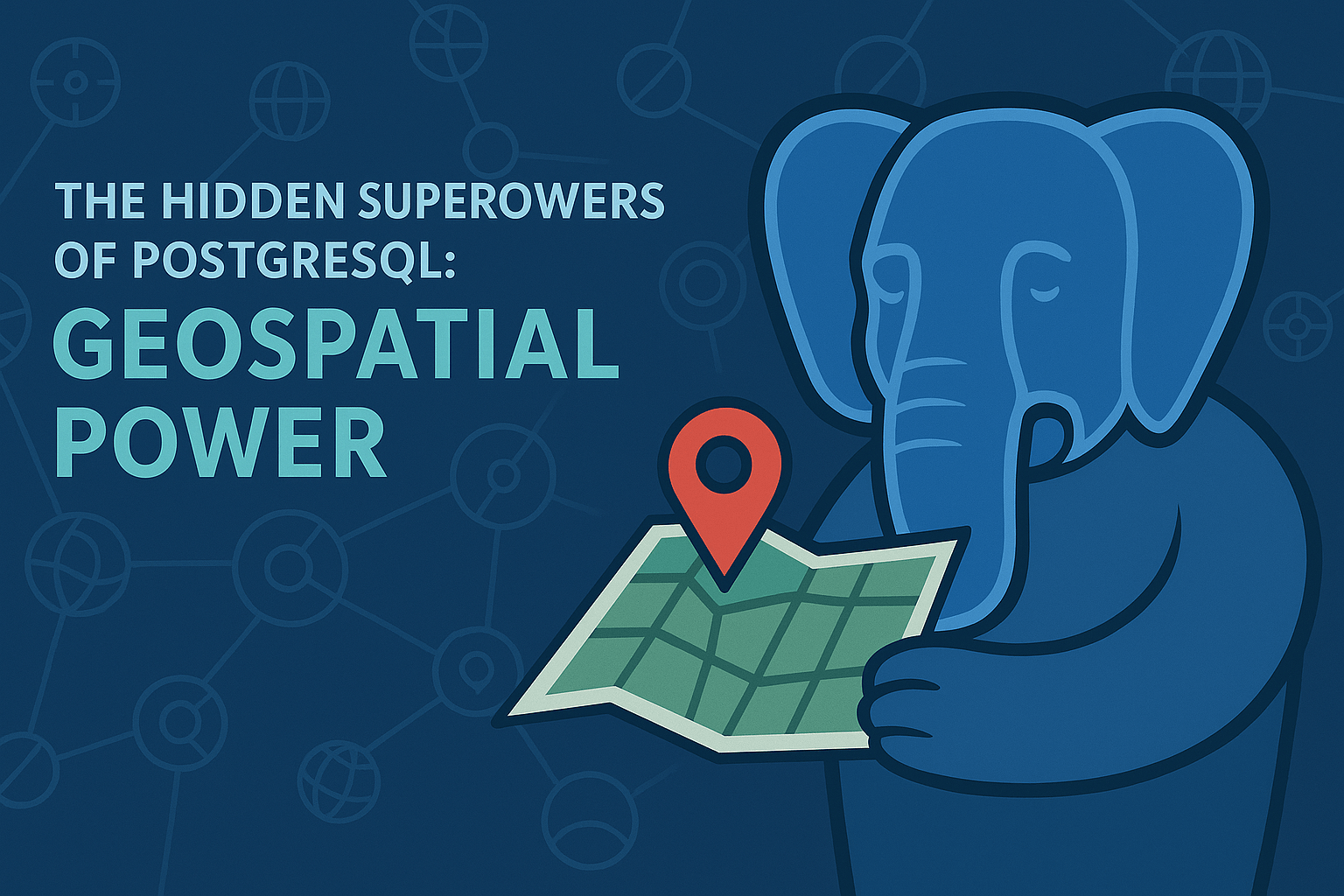When location matters, PostgreSQL doesn't just store coordinates - it thinks spatially.
I faced a daunting challenge recently: build a real estate valuation system that could analyze millions of property sales across an entire country over the last three years. The goal? Help users estimate their property's value by finding the nearest comparable sales based on location and property specifications.
My first thought was overwhelming: "This is going to require separate geospatial databases, complex data pipelines, and probably a dedicated mapping service."
Then I remembered PostgreSQL's PostGIS extension.
The Geospatial Challenge
The requirements seemed straightforward but computationally intense:
- Store millions of real estate transactions with precise coordinates
- Accept a user's property location and specifications
- Find similar properties within a reasonable distance
- Calculate proximity-based valuations in real-time
The traditional approach would involve exporting coordinates to specialized databases, building complex algorithms, and managing separate infrastructure. This meant significant complexity and substantial development time.
The PostGIS Revelation
Instead of building a complex multi-system architecture, I decided to explore what PostgreSQL could handle natively.
"What if one database could handle both my business logic and spatial calculations?"
That's when PostGIS proved to be a game-changer. PostGIS transforms PostgreSQL into a full-featured spatial database that understands geometric data types, spatial relationships, coordinate systems, and spatial indexing.
Setting Up PostGIS
Enabling spatial capabilities is remarkably simple:
CREATE EXTENSION postgis;This single command adds dozens of spatial functions and data types to your database.
For our real estate data, we can now store locations as geometric points:
CREATE TABLE real_estate_sales (
id SERIAL PRIMARY KEY,
address TEXT,
price DECIMAL(12,2),
bedrooms INTEGER,
bathrooms INTEGER,
square_footage INTEGER,
sale_date DATE,
location GEOMETRY(Point, 4326)
);The GEOMETRY(Point, 4326) column stores coordinates using the WGS84 coordinate system - the same system used by GPS devices worldwide.
Spatial Indexing: The Performance Secret
Here's where PostGIS really shines. We can create spatial indices that make geographic queries incredibly fast:
CREATE INDEX idx_real_estate_location
ON real_estate_sales
USING GIST (location);This GIST index allows PostgreSQL to quickly eliminate irrelevant records when performing spatial queries, even across millions of rows.
Real-World Spatial Queries
Finding Properties Within a Radius
-- Find all sales within 2km of a user's property
SELECT address, price, bedrooms, bathrooms,
ST_Distance(location, ST_SetSRID(ST_MakePoint(-73.935242, 40.730610), 4326)) as distance_meters
FROM real_estate_sales
WHERE ST_DWithin(
location,
ST_SetSRID(ST_MakePoint(-73.935242, 40.730610), 4326),
2000 -- 2000 meters = 2km
)
AND sale_date >= CURRENT_DATE - INTERVAL '1 year'
ORDER BY distance_meters;Finding the Closest Comparable Properties
-- Find 10 closest properties with similar specifications
SELECT address, price, square_footage,
ST_Distance(location, ST_SetSRID(ST_MakePoint(-73.935242, 40.730610), 4326)) as distance_meters
FROM real_estate_sales
WHERE bedrooms = 3
AND bathrooms >= 2
AND square_footage BETWEEN 1800 AND 2200
ORDER BY location <-> ST_SetSRID(ST_MakePoint(-73.935242, 40.730610), 4326)
LIMIT 10;The <-> operator returns the distance between geometries and is optimized for "nearest neighbor" queries.
Performance: The Numbers Don't Lie
Working with our dataset of 3 million real estate transactions, PostGIS delivered impressive performance:
- Point-in-radius queries: 15-25ms (finding properties within 2km)
- Nearest neighbor searches: 8-12ms (finding 10 closest properties)
- Complex polygon intersections: 30-50ms (neighborhood-based queries)
Without spatial indexing, these same queries would have taken several seconds or required full table scans.
Real-World Impact: What PostGIS Saved Us
By using PostGIS instead of a multi-system approach, we avoided:
Infrastructure Complexity
- No separate geospatial database to maintain
- No data synchronization between systems
- Single point of configuration and monitoring
Development Time
Instead of weeks building custom distance calculations and data pipelines, we implemented the core functionality in days using SQL queries.
Data Consistency
- Real-time spatial queries on live transactional data
- No synchronization lag between business logic and spatial data
- Atomic transactions across both business and spatial operations
Advanced Features: Beyond Basic Queries
PostGIS offers sophisticated capabilities that would be complex to implement manually:
Area-Based Searches
-- Find properties within a specific neighborhood polygon
SELECT COUNT(*), AVG(price)
FROM real_estate_sales
WHERE ST_Within(
location,
ST_GeomFromText('POLYGON((-73.9857 40.7484, -73.9857 40.7584, -73.9757 40.7584, -73.9757 40.7484, -73.9857 40.7484))', 4326)
);Integration with Business Logic
-- Complex business query combining spatial and non-spatial conditions
SELECT
neighborhood,
AVG(price) as avg_price,
COUNT(*) as sale_count
FROM real_estate_sales
WHERE ST_DWithin(
location,
(SELECT location FROM landmarks WHERE name = 'Central Park'),
5000 -- 5km radius
)
AND price BETWEEN 500000 AND 2000000
AND sale_date >= '2023-01-01'
GROUP BY neighborhood
HAVING COUNT(*) >= 10
ORDER BY avg_price DESC;This single query combines proximity analysis, price filtering, and grouping - operations that would require multiple systems without PostGIS.
The Broader Implications
This experience with PostGIS highlighted a crucial principle: before reaching for specialized tools, thoroughly explore what your existing stack can handle.
PostgreSQL with PostGIS isn't just a database with spatial features - it's a complete spatial database that can handle enterprise-level geographic applications. The real estate valuation system that seemed to require a complex multi-system architecture was elegantly solved with SQL queries and a single database extension.
PostGIS capabilities extend far beyond real estate applications: logistics optimization, retail location analysis, environmental monitoring, urban planning, IoT sensor networks, and location-based social applications.
Next time you're faced with a spatial computing challenge, consider whether PostGIS might already provide the solution you need.
This is the second article in our series exploring PostgreSQL's hidden superpowers. Sometimes the most powerful solutions are the ones hiding in plain sight.

